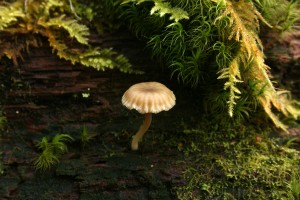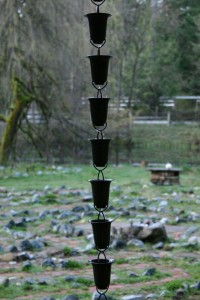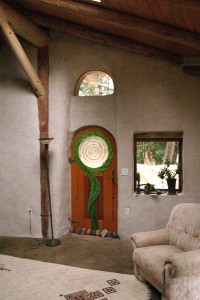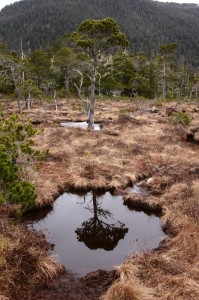At the first stop on a ferry trip down the Alaskan coast, I scrambled up a steep slope through a hemlock forest and my nose came close to the mossy carpet. the smell that greeted me was rich, earthy, it reminded me of a stout beer.  I sat down, my back to a tree; a varied thrush sang its long human-sounding whistled notes in the distance. My eyes ran over the green carpet that covered every surface, following the contours of logs and roots, and climbing the lower trunks of trees. Feather moss, fern moss, lanky moss, cat-tail moss, electrified cat tail moss; the names are descriptive of the unique forms. I didn’t know why the varied branching shapes, quilting an irregular pattern across the forest floor, broken here or there by a fallen hemlock twig or cone, brought such a sense of contentment – now I understand more.
I sat down, my back to a tree; a varied thrush sang its long human-sounding whistled notes in the distance. My eyes ran over the green carpet that covered every surface, following the contours of logs and roots, and climbing the lower trunks of trees. Feather moss, fern moss, lanky moss, cat-tail moss, electrified cat tail moss; the names are descriptive of the unique forms. I didn’t know why the varied branching shapes, quilting an irregular pattern across the forest floor, broken here or there by a fallen hemlock twig or cone, brought such a sense of contentment – now I understand more.
As the ferry sailed from Haines the sun was sinking low in the sky, and the snowy peaks of the coast mountains changed from fiery orange to cold blue. 
I was on my way to O.U.R. Ecovillage, a community on Vancouver Island, British Columbia, where I wanted to see buildings built out of earth, and meet the people who made them.
At O.U.R. Ecovillage I stayed in a building named the Sanctuary, on the edge of a cedar swamp. I sat for a while on a living cedar log, surrounded by showy yellow blooms of skunk cabbage, listening to the long complex song of the winter wren, like tiny raindrops on a still lake. Rain chains hanging from the corners of the living roof of the Sanctuary building echoed the wren’s song. As my ear was drawn to the patterns in the song, so my eye was drawn to the pattern in this chain of tiny bowls linking roof to earth, and the perpetual motion machine of the water trickling down it. Inside the building, my hand reached for rough earth plastered walls and the uneven smoothness of roundwood posts.  My feet pressed against the cool softness of an oiled earthen floor. My eye traced the linear path of beams to their meeting with curved walls, and subconsciously I found pattern in thousands of details of this building, each of which represented a choice made by a builder, and a statement about beauty.
My feet pressed against the cool softness of an oiled earthen floor. My eye traced the linear path of beams to their meeting with curved walls, and subconsciously I found pattern in thousands of details of this building, each of which represented a choice made by a builder, and a statement about beauty.
Traditionally beauty is in the realm of art, not science. Lately, however, the two may be intersecting. Biophilia is a word used by evolutionary biologist E.O. Wilson to describe an evolved human affinity for nature. In 1961, as a young naturalist, Wilson first visited the rainforests of Surinam. As he became lost in the richness of the natural world here, he realized there was some larger idea that was eluding him. More than two decades later he would write “the image of the land I kept for many years symbolized the tangle of dreams and boyhood adventures from which I had originally departed, the home country of all naturalists, and the quiet refuge from which personal beliefs might be redeemed in a permanent and more nearly perfect form.” A poetic description of the naturalist’s experience, but Wilson came to believe that his own intense connections to nature are merely expressions of a broader human connection to the natural world, which has a genetic basis.
 According to Wilson’s theory, being in contact with nature makes humans happier and healthier; and since it’s in our genes it is cross-cultural – everyone, rich or poor, rural or urban, will find solace in nature. One of the implications of this is that we may find something beautiful, or comfortable, because it emulates patterns found in nature. From there it’s only a short leap to design buildings that emulate natural patterns and processes. Termed biophilic design, it’s a leap that a number of architects and psychologists have already begun to make.
According to Wilson’s theory, being in contact with nature makes humans happier and healthier; and since it’s in our genes it is cross-cultural – everyone, rich or poor, rural or urban, will find solace in nature. One of the implications of this is that we may find something beautiful, or comfortable, because it emulates patterns found in nature. From there it’s only a short leap to design buildings that emulate natural patterns and processes. Termed biophilic design, it’s a leap that a number of architects and psychologists have already begun to make.
I’m reminded of a scene from the movie Black Robe, in which a Jesuit priest, lost in the Canadian forest, looks up into the trees and sees for a moment the columns in a cathedral. It’s a cinematic moment that has stuck with me when most other details of the movie have dropped away. Mathematician Nikos Salingaros suggests that some of the greatest religious architecture relies on natural patterns and symmetries to connect humans to the divine. According to Salingaros, “we engage emotionally with the built environment through architectural forms and surfaces. We experience our surroundings no differently than we experience natural environments, other living creatures, and other human beings.”
Biophilic design is not new; arguably it is best exemplified in traditional, or vernacular, architecture and often finds itself in opposition to modern, minimalist architecture. Consider some of the shared aspects of the forest and the sanctuary building. My senses were engaged. The earthy smell of moss in the forest, the faint odours of earth plasters and natural oils; songs of varied thrush and winter wren, the bell-like sound of the rain chains; the bark of a cedar tree and the feel of earth plaster that my hand instinctively reaches out to touch. We tend to think of what we see, but we engage the world with all of our senses.
 Visually, I am drawn to ordered, but complex patterns. The parallel rafters as they meet the rounded wall, the rain chains. Or moss, like snowflakes never twice the same. This repetition of similar patterns has been called visual rhyming. Rhyming patterns occur on different scales, in the building or in the forest. Sometimes the pattern is only a texture when perceived from afar, but greater and greater detail is revealed as one moves closer. Michael N. Corbett describes this as an attraction to neither rigid uniformity nor wide variation, but rather small variations and imperfections in a general pattern. We are attracted to that which is made by hand, rather than by machine. At some very base level, it seems, we are all luddites.
Visually, I am drawn to ordered, but complex patterns. The parallel rafters as they meet the rounded wall, the rain chains. Or moss, like snowflakes never twice the same. This repetition of similar patterns has been called visual rhyming. Rhyming patterns occur on different scales, in the building or in the forest. Sometimes the pattern is only a texture when perceived from afar, but greater and greater detail is revealed as one moves closer. Michael N. Corbett describes this as an attraction to neither rigid uniformity nor wide variation, but rather small variations and imperfections in a general pattern. We are attracted to that which is made by hand, rather than by machine. At some very base level, it seems, we are all luddites.
This doesn’t imply that we all need to live in a cob house. Natural materials and design aspects can be incorporated into any building, and always have been. Many conventions in architecture and interior design probably derive from the natural world. I live in a 100-year-old building with wood floors and beautiful mouldings, and (recently added) earth plasters. I would say that many of the deliberate, and unconscious details of this building do reflect biophilic design. My addition of earth plaster only enhances this. The trouble with biophilic design is that so far we don’t really understand what it is, or what rules it follows. Even so, it’s a valuable concept to keep in mind while designing or choosing materials.
A good book of articles about biophilic design is edited by Stephen Kellert.
I haven’t seen this film yet, but I will when I have the chance.
Biophilic Design: The Architecture of Life (Trailer) from Tamarack Media on Vimeo.

Leave a Reply